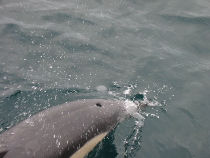Types of Dolphins |
Different Types of DolphinsThe Delphinidae are both the largest family of dolphins and the largest family within the order Cetacea. They are commonly referred to as the ocean dolphins even though some still retain the name whale. These types of dolphins do vary hugely in appearance and size and shape. However, many morphological characteristics are common to nearly all the delphinid species. As with other toothed whales, Odontoceti, they have a single blowhole situated at the top of the head just left of center and a dorsal fin midway between the head and flukes. Although the number of teeth varies within the different genera and species, they are usually undifferentiated and conical in shape, unlike the Porpoises whose teeth are more spade shaped. The beak length and width is highly variable between the different species and types of dolphins; some members have little or no differentiated beak while others demonstrate a prominent and distinct beak. There is always a notch in the trailing edge of the tail flukes and colouration varies between bold black and white with tan patches and bold stripes to the more muted greys and even white. The Delphinidae, or ocean dolphin family, contain six subfamilies with over 16 genera and at least 33 species although taxonomists do disagree on occasion as to the exact number of species within this family. It is only within the last 30 years that some species, such as the Clymene Dolphin, have been recognized as a separate species. Types of PorpoiseSix types of porpoises currently reside in the world's oceans all belonging to the family Phocoenidae. They include, Burmeister's Porpoise, Dall's Porpoise, the Finless Porpoise, the Harbour Porpoise, the Spectacled Porpoise and the rare Vaquita. These largely cryptic animals have drawn little attention to themselves until the later part of the 20th century when it became apparent that a large number of these animals were becoming entangled in static fishing gear. By the 1990's authorities were becoming seriously concerned with regard to the survival of some species of porpoise because of incidental deaths due to bycatch. Much effort has been put into reducing bycatch using acoustic devices and limiting fishing activities to certain times of the year. It is however, likely that the rare Vaquita, a porpoise limited to the Gulf of California with a population numbering some 500 animals, will have the dubious distinction, within the next decade, of becoming the first cetacean to suffer species extinction at the hands of mankind. A balenopterid, the Northern Right Whale is likely to become the second. All these types of porpoise around the world continue to be exceptionally vulnerable to coastal fishing practices and a great deal of work still needs to be done to curb porpoise deaths due to bycatch. The porpoises differ from dolphins by having chisel shaped teeth, no beak and a more triangular shaped dorsal fin.
Read more about:
Return to TopOur Dolphin & Whale Watching Tours
|
Click on images for larger view:
|
Whale WatchingWhale Watching in IrelandWhale Watching TripsWhale Watching HolidaysDolphin WatchingDolphin EncountersDolphin HolidaysOther Marine Wildlife Tours |
More About WhalesWhale ConservationWhale PicturesMore About DolphinsDolphin PicturesPorpoisesSealsAbout
|












